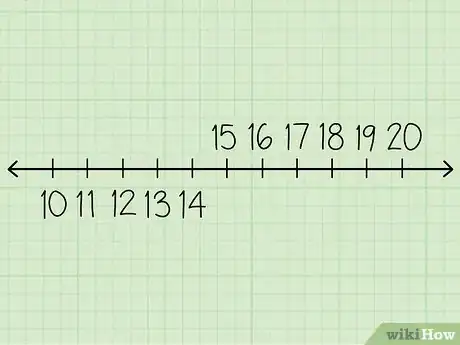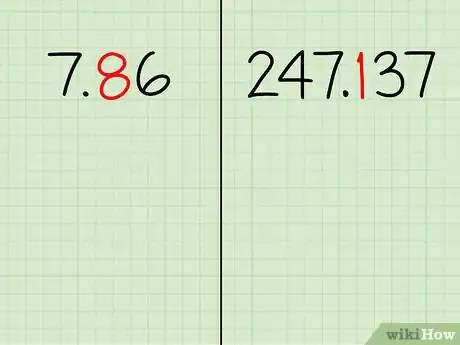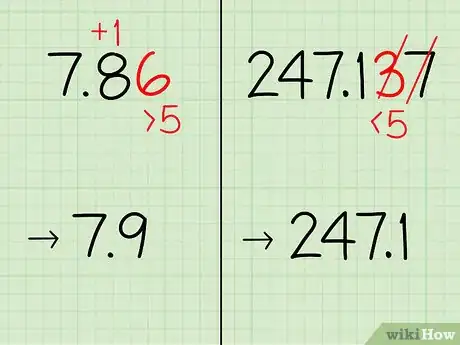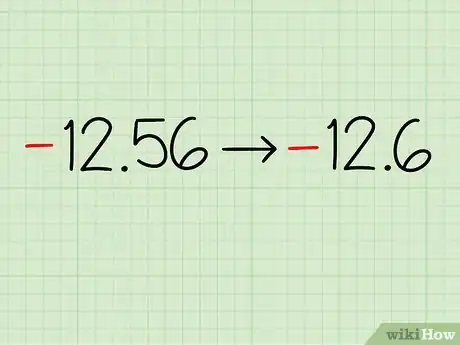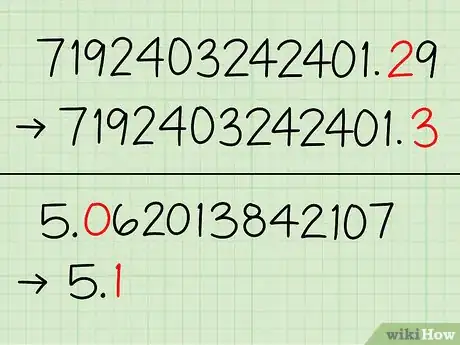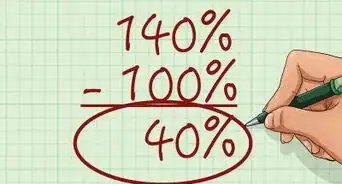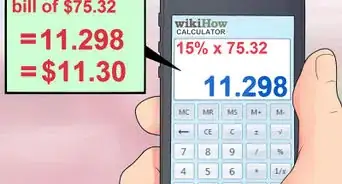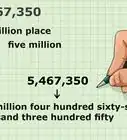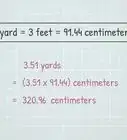wikiHow is a “wiki,” similar to Wikipedia, which means that many of our articles are co-written by multiple authors. To create this article, 11 people, some anonymous, worked to edit and improve it over time.
There are 7 references cited in this article, which can be found at the bottom of the page.
This article has been viewed 455,715 times.
Learn more...
Many situations will call for you to round decimals to the nearest tenth to make the number easier to work with. Once you understand how to find the tenths and hundredths place, the process is very similar to rounding whole numbers.
Steps
Rounding to the Nearest Tenth
-
1Review rounding on a number line (optional). Let's ignore the decimals for a moment and try rounding to tens instead. Draw a number line from 10 to 20. The numbers on the left half of the line (like 13 or 11) are closer to 10, so they round to 10. The numbers on the right half (like 16 or 17) are closer to 20, so they round to 20. Rounding with decimals can seem confusing, but it's really the same process. You could relabel your number line as "0.10, 0.11, 0.12, ..., 0.19, 0.2" and you'd have a number line for rounding to the nearest tenth.[1]
-
2Write down a number with a decimal point. It doesn't matter how many digits come after the decimal.
- Example 1: Round 7.86 to the nearest tenth.
- Example 2: Round 247.137 to the nearest tenth.
Advertisement -
3Find the tenths place. The tenths place is immediately to the right of the decimal point.[2] After rounding to the nearest tenth, this will be the final digit in your number. For now, just underline this digit.
- Example 1: In the number 7.86, the 8 is in the tenths place.
- Example 2: In the number 247.137, the 1 is in the tenths place.
-
4Look at the hundredths place. The hundredths place is the digit to the right of the decimal point. This digit tells you whether to round up or down.
- Example 1: In the number 7.86, the 6 is in the hundredths place.
- Example 2: In the number 247.137, the 3 is in the hundredths place.
- The digits to the right of the hundredths do not matter when you're rounding to the nearest tenth. They represent "extra stuff" too small to make a difference.
-
5Round the tenths place up if the hundredths place is 5 or more. Is the digit in the hundredths place is 5, 6, 7, 8, or 9? If it is, "round up" by adding 1 to the tenths place digit. Get rid of all digits after the tenths place, and you have your answer.[3]
- Example 1: The number 7.86 has a 6 in the hundredths place. Round up by adding 1 to the tenths place to get 7.9, removing the digits to the right.
-
6Round down if the hundredths place is 4 or less. Is the digit in the hundredths place 4, 3, 2, 1, or 0? If it is, "round down" by leaving the tenth place as it is. Just remove any digits in the hundredths place and further to the right.[4]
- Example 2: The number 247.137 has a 3 in the hundredths place. Round down by removing everything past the tenths place, to get 247.1.
Special Cases
-
1Round down to a zero in the tenths place. If there's a zero in the tenths place and your round down, keep the zero in your answer. For example, 4.03 rounded to the nearest tenth is 4.0. This gives people a better idea of the accuracy of your number. Just writing "4" isn't wrong, but it hides the fact that you were working with decimals.
-
2Round negative numbers. Rounding negative numbers is basically the same as rounding positive numbers. Follow the same process and always keep the minus sign in your answer. For example, -12.56 round to -12.6, and -400.333 rounds to -400.3.
- Be careful about using the phrases "round down" and "round up." If you look at a number line for negative numbers, you'll see that rounding -12.56 to -12.6 moves left, so that's "rounding down" even though you increased the tenth digit by 1.
-
3Round extra long numbers. Don't get confused by super long numbers. The rules stay the same. Find the tenths place and figure out whether to round up or down. After rounding, all the numbers to the left of the tenths place will stay the same, and all the numbers to the right of the tenths place will disappear. Here are three examples:[5]
- 7192403242401.29 rounds to 7192403242401.3
- 5.0620138424107 rounds to 5.1
- 9000.30001 rounds to 9000.3
-
4Keep numbers with no hundredths place the same. Does the number end in the tenths place, with nothing further to the right? This number is already rounded to the nearest tenth, so you don't need to do anything here. Your textbook might be trying to trick you.
- For example, 1509.2 is already rounded to the nearest tenth.
Expert Q&A
Did you know you can get premium answers for this article?
Unlock premium answers by supporting wikiHow
-
QuestionShould I round .5 up, or down?
 Mario Banuelos, PhDMario Banuelos is an Assistant Professor of Mathematics at California State University, Fresno. With over eight years of teaching experience, Mario specializes in mathematical biology, optimization, statistical models for genome evolution, and data science. Mario holds a BA in Mathematics from California State University, Fresno, and a Ph.D. in Applied Mathematics from the University of California, Merced. Mario has taught at both the high school and collegiate levels.
Mario Banuelos, PhDMario Banuelos is an Assistant Professor of Mathematics at California State University, Fresno. With over eight years of teaching experience, Mario specializes in mathematical biology, optimization, statistical models for genome evolution, and data science. Mario holds a BA in Mathematics from California State University, Fresno, and a Ph.D. in Applied Mathematics from the University of California, Merced. Mario has taught at both the high school and collegiate levels.
Assistant Professor of Mathematics
-
QuestionHow do I round to the nearest hundredth?
 Mario Banuelos, PhDMario Banuelos is an Assistant Professor of Mathematics at California State University, Fresno. With over eight years of teaching experience, Mario specializes in mathematical biology, optimization, statistical models for genome evolution, and data science. Mario holds a BA in Mathematics from California State University, Fresno, and a Ph.D. in Applied Mathematics from the University of California, Merced. Mario has taught at both the high school and collegiate levels.
Mario Banuelos, PhDMario Banuelos is an Assistant Professor of Mathematics at California State University, Fresno. With over eight years of teaching experience, Mario specializes in mathematical biology, optimization, statistical models for genome evolution, and data science. Mario holds a BA in Mathematics from California State University, Fresno, and a Ph.D. in Applied Mathematics from the University of California, Merced. Mario has taught at both the high school and collegiate levels.
Assistant Professor of Mathematics Look at what is in the thousandths place and round up or down based on that. Your result should have 2 decimal places, unless there is a 0 in the hundredths place and something smaller than 1 in the thousandths place. For example, 7.586 would round up to 7.59. 2.324 would round down to 2.32. 6.301 would round down to 6.3.
Look at what is in the thousandths place and round up or down based on that. Your result should have 2 decimal places, unless there is a 0 in the hundredths place and something smaller than 1 in the thousandths place. For example, 7.586 would round up to 7.59. 2.324 would round down to 2.32. 6.301 would round down to 6.3. -
QuestionIs there a calculator for rounding numbers?
 wikiHow Staff EditorThis answer was written by one of our trained team of researchers who validated it for accuracy and comprehensiveness.
wikiHow Staff EditorThis answer was written by one of our trained team of researchers who validated it for accuracy and comprehensiveness.
Staff Answer wikiHow Staff EditorStaff Answer
wikiHow Staff EditorStaff Answer
References
- ↑ https://www.khanacademy.org/math/arithmetic/arith-decimals/arith-review-rounding-decimals/v/rounding-decimals-on-the-number-line
- ↑ https://www.purplemath.com/modules/placeval3.htm
- ↑ https://www.cuemath.com/numbers/round-to-the-nearest-tenth/
- ↑ https://www.cuemath.com/numbers/round-to-the-nearest-tenth/
- ↑ https://www.mathsisfun.com/rounding-numbers.html
- ↑ http://mathforum.org/library/drmath/view/58961.html
- https://www.mathsisfun.com/rounding-numbers.html
- https://www.khanacademy.org/math/pre-algebra/decimals-pre-alg/dec-rounding-estimation-pre-alg/v/rounding-decimals
About This Article
Rounding to the nearest tenth is a method for making long decimals easier to deal with. To do it, write down a number that includes a decimal, such as 7.82. Then, locate the tenths place, which is the first place after the decimal point. In this case, the number 8 is in the tenths place. Next, look at the number in the hundredths place, which is just to the right of the tenths place. If it’s equal to or greater than 5, round up the number in the tenths place and drop the number in the hundredths place. For instance, 1.65 would round up to 1.7. If it’s less than 5, round down and keep the number in the tenths place the same. In our example of 7.82, you would round down to 7.8. Similarly, if there’s no number after the tenths place, you don’t have to do anything—just leave the number in the tenths place the same. While rounding to the tenths place is usually pretty simple, there are a couple of special situations to keep in mind. For instance, if there’s a 9 in the tenths place and a number greater than or equal to 5 in the hundredths place, you’ll need to round up the number in the ones place (to the left of the decimal point) and change the number in the tenths place to 0. So, if you’re rounding up the number 12.981, you’d round up to 13.0. If you’re working with a negative number, rounding works the same way as with a positive number. However, be aware that when you round “up” a negative number, you’re actually making the number smaller, or moving it further to the left of 0 on the number line. But the magnitude of the number will still increase, just like when you round up a positive number. So, for example, you’d still round -18.76 to -18.8, but keep in mind that -18.8 is less than -18.76. For more tips, including how to round numbers with no hundredths place, scroll down!
